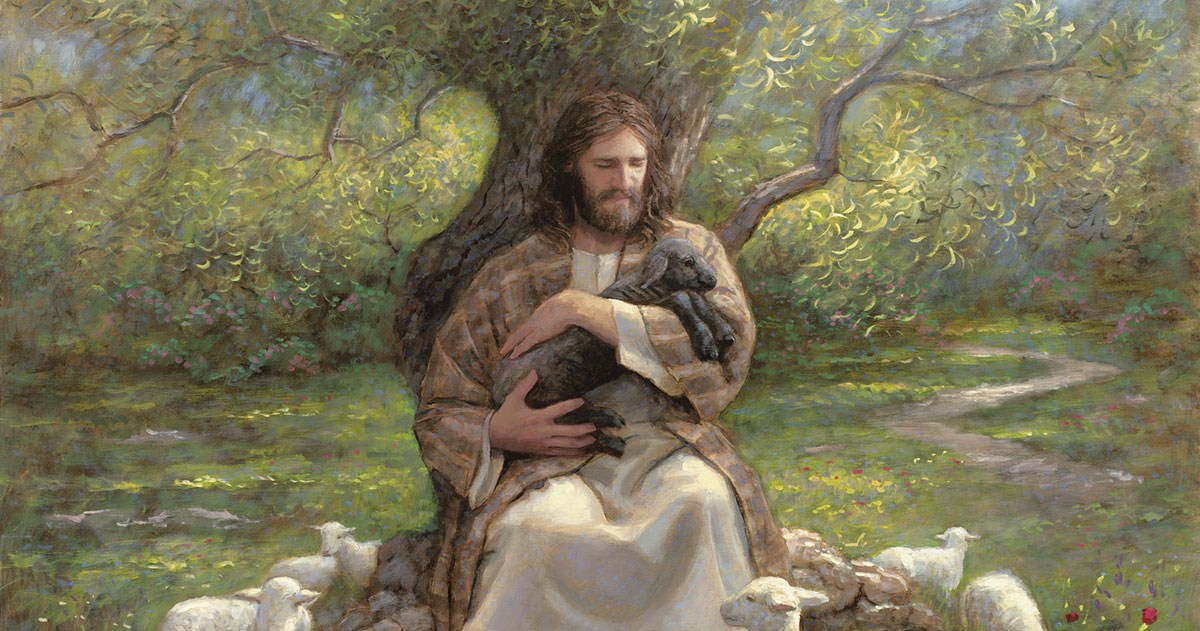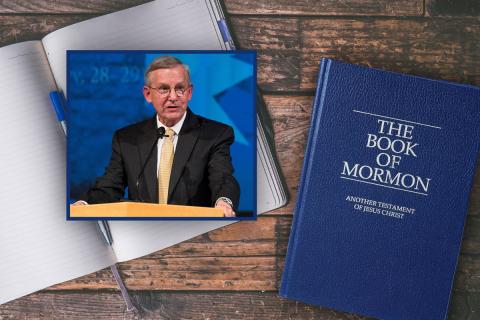You are here
Book of Mormon Central is in the process of migrating to our new Scripture Central website.
We ask for your patience during this transition. Over the coming weeks, all pages of bookofmormoncentral.org will be redirected to their corresponding page on scripturecentral.org, resulting in minimal disruption.
Come Follow Me 2020: Alma 5–7

Scripture Block
Alma 5-7
June 1–7. “Have Ye Experienced This Mighty Change in Your Hearts?”
KnoWhys
Recommended Resources
Learn about the Book of Mormon with verse by verse commentaries from renowned Book of Mormon scholars like John W. Welch and Brant A. Gardner in the ScripturePlus app. Read this week's KnoWhy connected with the Come Follow Me curriculum, and watch a video elucidating an insight in this week's scripture reading.
Reading Plan
Structure your personal scripture study by following a multimedia, day by day plan. Each day's assignment includes the required scripture passages from the Come Follow Me curriculum, as well as suggestions for additional resources to bring context and understanding to your study. To dive deeper, skip down to Additional Resources for a selected bibliography on this week's chapters. If you are looking to dive deep into your study, skip down to "Additional Resources" for a selected bibliography of articles, books, and chapters on Alma 5–7.
Monday
- Scripture: Alma 5:1–13
- Chart: 50 Questions of Alma 5: Overview
-
Quote: “Alma intends to draw parallels between this people and his father’s church by the Waters of Mormon. First, those Nephites were in bondage to the Lamanites.... Second, Yahweh’s power delivered Alma’s father’s people from Lamanite bondage. Alma wanted to emphasize the power of faith and [God’s] power to deliver, logically suggesting that [God’s] power will also resolve their current situation. Third, Alma’s father’s converts came to Zarahemla and established ‘the church of God,’ of which his listeners are members. This statement forcefully brings history into the present. Symbolically, the current church will have the same option as that earlier church, and it, too, may be delivered by [God's] word.”
Gardner, Brant. Second Witness: Analytical and Contextual Commentary on the Book of Mormon. Salt Lake City, UT: Greg Kofford Books, 2007, 4:91. - KnoWhy 112: Why Did Alma Ask Church Members Fifty Probing Questions?
Explore Further
Tuesday
- Scripture: Alma 5:14–42
-
Quote: “An ‘image’ is not just an outward visual impression but also a vivid representation, a graphic display, or a total likeness of something. It is a person or thing very much like another, a copy or counterpart. Likewise, countenance does not simply mean a facial expression or visual appearance. The word comes from an old French term originally denoting ‘behavior,’ ‘demeanor,’ or ‘conduct.’ In earlier times the word countenance was used with these meanings in mind….
“According to Alma, the mighty change of heart must be ‘experienced.’ Perhaps that is why the concept of spiritual rebirth, ‘being born again,’ is considered by some to be difficult to talk about. In fact, it was never intended to be merely ‘understood’ intellectually or in a passive sense. It must be personally experienced. Alma wanted his audience to be active participants. Those who experienced it, said Alma, have ‘felt to sing the song of redeeming love.’ Other scripture confirms that it was so in ancient times as well. Alma hoped that his people would retain this blessed and favored state; for only by remaining ‘steadfast and immovable, always abounding in good works’ can celestial glory be guaranteed.”
Skinner, Andrew C. “Alma's 'Pure Testimony.'” Essay. In Studies in Scripture, Volume 7: 1 Nephi to Alma 29, edited by Kent P. Jackson, 301-302. Salt Lake City, UT: Deseret Book. Co., 1987. - KnoWhy 295: Why Did Alma Ask about Having God’s Image Engraven upon One’s Countenance?
Wednesday
- Scripture: Alma 5:43–50
-
Quote: “From Adam to Moses and from Moses to Christ, God's prophets and priests offered sacrifices. Such were in the similitude of the sacrifice of the Only Begotten of the Father who was to come. When Moses lifted the serpent on the pole in ancient Israel and told the Israelites that those who would look would live when they were bitten by poisonous serpents, it was in similitude of the fact that the Son of God would be lifted up on the cross and that all who would look to him might live eternally. Every ordinance of the gospel is designed to point and center the attention of men in Christ . . . Every prophet that there has been in the world has borne record that he is the Son of God, because in its very nature that is the chief calling of a prophet. The testimony of Jesus is synonymous with the spirit of prophecy.”
McConkie, Bruce R. “What Think Ye of Christ?” General Conference October 1948.
Thursday
- Scripture: Alma 5:51–62
-
Quote: “As with most metaphors in scripture, trees represent people. The root of the tree is the essential core, the source and supplier for the body of the tree, which should bear fruit. The fruit represents ‘works of righteousness.' ‘If the root be holy, so are the branches,' but if the root system becomes corrupted by absorbing poisonous elements from its environment, then ‘the ax is laid at the root of the tree,’ and it will have to be cut down and cast into the fire. The fire into which the wicked ‘trees’ are cast is the fire of hell.... Those who are cast into the fire are described in Alma 5:53–56.”
Ogden, D. Kelly, and Andrew C. Skinner. Verse by Verse: The Book of Mormon. Salt Lake City, UT: Deseret Book, 2011, 1:395. -
Quote: “In an attempt to further prepare the Saints against the inevitable threatening wolves, Paul the Apostle gave his warning: “For I know this, that after my departing shall grievous wolves enter in among you, not sparing the flock.” Where might these wolves get sheep’s clothing that is so authentic as to deceive the Lord’s flock? Could it be they are clothed with exceeding riches and fine clothing as Mormon warned? The vainness and frailties and foolishness of men, the learned that hearken not unto the commandments of God, as Jacob warned? Could it be that sometimes they may clothe themselves to appear as righteous shepherds, that even the very elect might be deceived?”
Edgley, Richard C. “Keep the Faith.” General Conference April 1993.
Friday
- Scripture: Alma 6:1–8
- KnoWhy 114: Why Did Alma Need to “Establish the Order of the Church” in Zarahemla Again?
Saturday
- Scripture: Alma 7:1–13
- Chart: The Speeches of Alma
- Chart: What Did Alma Reveal about the Savior’s Mission?
Explore Further
- Q&A: Why Does Alma say Jesus would be “born of Mary at Jerusalem which is the land of our forefathers”?
- KnoWhy 323: What Did Alma Reveal about the Savior’s Mission?
Sunday
- Scripture: Alma 7:14–27
- KnoWhy 114: Why Does Alma Mention Three Kinds of Paths in One Verse?
Additional Resources (Bibliography)
Alma 5
Baker, LeGrand L., and Stephen D. Ricks. “Alma 5: The Song of Redeeming Love.” In Who Shall Ascend into the Hill of the Lord?: The Psalms in Israel’s Temple Worship in the Old Testament and in the Book of Mormon, 520–537. 2nd ed. Salt Lake City: Eborn Books, 2011.
Rees, Robert A. “Alma the Younger's Seminal Sermon at Zarahemla.” In Bountiful Harvest: Essays in Honor of S. Kent Brown. Edited by Andrew C. Skinner, D. Morgan Davis, and Carl Griffin. Provo, UT: Neal A. Maxwell Institute for Religious Scholarship, 2011.
Welch, John W., and Greg Welch. “50 Questions of Alma 5: Overview.” In Charting the Book of Mormon: Visual Aids for Personal Study and Teaching. Provo, UT: Foundation for Ancient Research and Mormon Studies, 1999, chart 61.
Welch, John W., and Greg Welch. “50 Questions of Alma 5: Questions 1–17.” In Charting the Book of Mormon: Visual Aids for Personal Study and Teaching. Provo, UT: Foundation for Ancient Research and Mormon Studies, 1999, chart 62.
Welch, John W., and Greg Welch. “50 Questions of Alma 5: Questions 18–29.” In Charting the Book of Mormon: Visual Aids for Personal Study and Teaching. Provo, UT: Foundation for Ancient Research and Mormon Studies, 1999, chart 63.
Welch, John W., and Greg Welch. “50 Questions of Alma 5: Questions 30–40.” In Charting the Book of Mormon: Visual Aids for Personal Study and Teaching. Provo, UT: Foundation for Ancient Research and Mormon Studies, 1999, chart 64.
Welch, John W., and Greg Welch. “50 Questions of Alma 5: Questions 41–50.” In Charting the Book of Mormon: Visual Aids for Personal Study and Teaching. Provo, UT: Foundation for Ancient Research and Mormon Studies, 1999, chart 65.
Alma 5:9
Book of Mormon Central. “Why Did Alma Add “Chains of Hell” to Abinadi’s Phrase “Bands of Death”? (Alma 5:9).” KnoWhy 111 (May 31, 2016).
Alma 5:14–15
Book of Mormon Central. “Why Did Alma Ask Church Members Fifty Probing Questions? (Alma 5:14–15).” KnoWhy 112 (June 1, 2016).
Alma 5:19
Book of Mormon Central. “Why Did Alma Ask about Having God’s Image Engraven upon One’s Countenance? (Alma 5:19).” KnoWhy 295 (April 3, 2017).
Caldwell, C. Max. “’A Mighty Change.’” In The Book of Mormon: Alma, The Testimony of the Word, edited by Monte S. Nyman and Charles D. Tate, Jr., 27–46. Provo, UT: Religious Studies Center, Brigham Young University, 1992.
Alma 5:33–34
Calabro, David. “’Stretch Forth Thy Hand and Prophesy’: Hand Gestures in the Book of Mormon.” Journal of the Book of Mormon and Other Restoration Scripture 21, no. 1 (2012): 46–59.
Welch, John W., and Greg Welch. “Three Trees in the Book of Mormon.” In Charting the Book of Mormon: Visual Aids for Personal Study and Teaching. Provo, UT: Foundation for Ancient Research and Mormon Studies, 1999, chart 95.
Alma 5:40
Parry, Donald W. “Antithetical Parallelism in the Book of Mormon.” In Reexploring the Book of Mormon, edited by John W. Welch, 167–169. Provo, UT/Salt Lake City: FARMS/Deseret Book, 1992.
Alma 6
Reeve, Jr., Rex C. “Dealing with Opposition to the Church.” In The Book of Mormon: Alma, The Testimony of the Word, edited by Monte S. Nyman and Charles D. Tate, Jr., 15–25. Provo, UT: Religious Studies Center, Brigham Young University, 1992.
Alma 6:4
Book of Mormon Central. “Why Did Alma Need to “Establish the Order of the Church” in Zarahemla Again? (Alma 6:4).” KnoWhy 113 (June 2, 2016).
Alma 7
Alma 7:9
Book of Mormon Central. “Why Do New Testament Words and Phrases Show up in the Book of Mormon? Part 3: Revelations to Nephite Prophets as a Source (Part A) (Alma 7:9).” KnoWhy 529 (August 29, 2019).
Alma 7:10
Book of Mormon Central. “Why does the Book of Mormon refer to the ‘land of Jerusalem’?” Q&A February 1, 2018.
Smith, Robert F. “The Land of Jerusalem: The Place of Jesus’ Birth.” In Reexploring the Book of Mormon, edited by John W. Welch, 170–172. Provo, UT/Salt Lake City: FARMS/Deseret Book, 1992.
Thomasson, Gordon C. “Revisiting the Land of Jerusalem.” In Pressing Forward with the Book of Mormon: The FARMS Updates of the 1990s, edited by John W. Welch and Melvin J. Thorne, 139–141. Provo, UT: FARMS, 1999.
Tvedtnes, John A. “Notes and Communications: Knowledge of Christ to Come.” Journal of Book of Mormon Studies 5, no. 1 (1996): 159–161.
Tvedtnes, John A. “Notes and Communications: Cities and Lands in the Book of Mormon.” Journal of Book of Mormon Studies 4, no. 2 (1995): 147–150.
Bokovoy, David E., and John A. Tvedtnes. “Cities and Lands in the Book of Mormon.” In Testaments: Links between the Book of Mormon and the Hebrew Bible, 184–188. Toelle, UT: Heritage Press, 2003.
Ogden, Kelly D. “I Have a Question: Why does the Book of Mormon say that Jesus would be born in Jerusalem?” Ensign August 1984.
Alma 7:11–13
Book of Mormon Central. “What Did Alma Reveal about the Savior’s Mission? (Alma 7:11–13).” KnoWhy 323 (June 7, 2017).
Rappleye, Neal. “Nephite History in Context 2: Special Issue.” Studio et Quoque Fide (December 2017).
Wayment, Thomas A. “The Hebrew Text of Alma 7:11.” Journal of Book of Mormon Studies 14, no. 1 (2005): 98–103, 130.
Alma 7:19
Book of Mormon Central. “Why Does Alma Mention Three Kinds of Paths in One Verse? (Alma 7:19).” KnoWhy 114 (June 3, 2016).
Hoskisson, Paul Y. “Straightening Things Out: The Use of Strait and Straight in the Book of Mormon.” Journal of Book of Mormon Studies 12, no. 2 (2003): 58–71, 114–117.
Welch, John S. “Straight (not Strait) and Narrow.” Journal of Book of Mormon Studies 16, no. 1 (2007): 18–25, 83-84.



